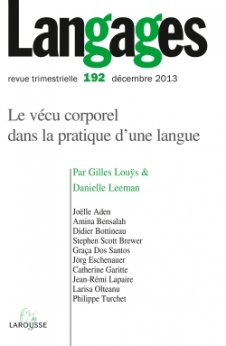
Langages n° 192 (4/2013)
Pour acheter ce numéro, contactez-nous
Recevez les numéros de l'année en cours et accédez à l'intégralité des articles en ligne.
L’interculturation du monde, la réorganisation systémique des espaces socio-économiques et les avancées des neurosciences cognitives placent les didactiques des langues et des cultures dans un « paradigme de la reliance » (Aden, Grimshaw & Penz 2010). Nous nous intéresserons ici plus précisément aux théories neuro-phénoménologiques qui nous invitent à reconsidérer la place de l’expérience corporelle, sensorielle et émotionnelle dans le développement des compétences langagières. Dans cet article, nous verrons comment le théâtre, prenant appui sur les mécanismes d’empathie (imitation, résonance, anticipation), nous invite à imaginer de nouvelles pédagogies interculturelles et plurilingues.
Given the ever greater degree of mutual exchange between cultures in today’s world, the systemic reorganization of socioeconomic functioning, as well as the unprecedented advances made in the cognitive neurosciences, research into the teaching of foreign language and culture has moved into what some now call a “paradigm of interrelatedness” (Aden, Grimshaw, Penz 2010). Neurophenomenological theories enable scientific inquiry into the role of embodied, sensory and emotional experience in learning to communicate in a foreign language. In this article, we look at how theater arts can be used to design new intercultural and plurilingual approaches to foreign language teaching by drawing on learners’ empathic dispositions to relate to others and otherness.